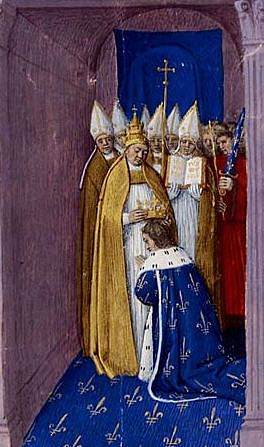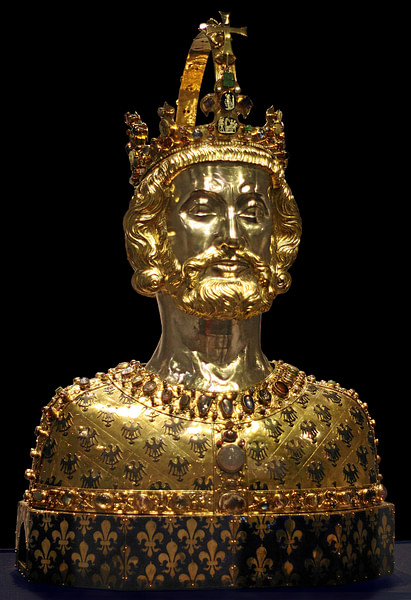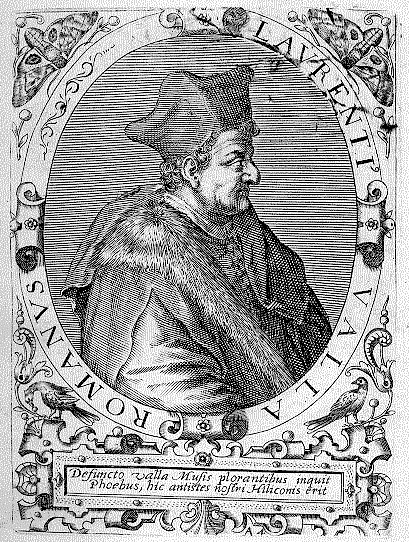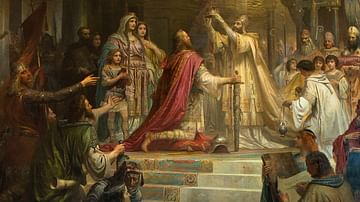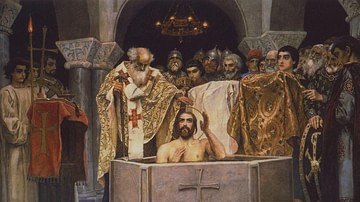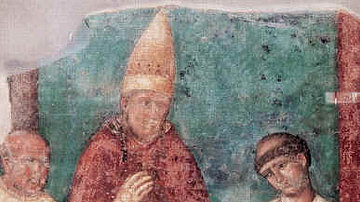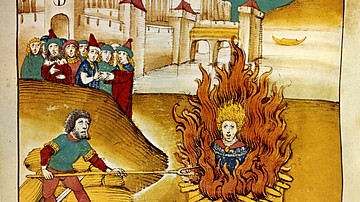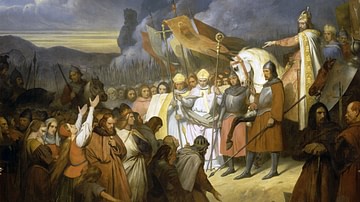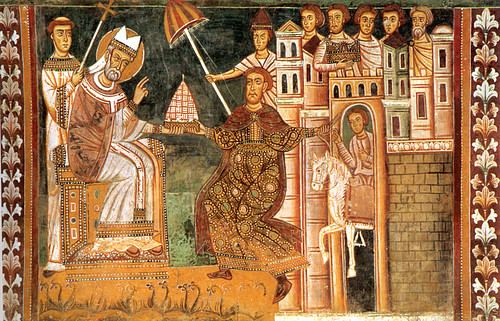
The Donation of Constantine (Donatio Constantini or the Donatio) is a medieval forgery dated to the 8th century purporting to be an original 4th-century document in which the Roman emperor Constantine the Great (r. 306-337) granted supreme temporal and spiritual power to the Church.
The document claims that in c. 315-317, Constantine was cured of leprosy by Pope Sylvester I (served 315-335) and, in gratitude, surrendered his power and lands to the pope and the pope then generously gave that power back, allowing the emperor his reign.
The Donation of Constantine was most likely written, and almost certainly used, to coerce Pepin the Short, King of the Franks (r. 751-768) into giving the lands he conquered from the Lombards to the Church under Pope Stephen II (served 752-757), was used again – this time with no effect – with Pepin's son Charlemagne (l. 742-814), and made appearances throughout the reigns of later European monarchs until it was finally proved a forgery by the priest and scholar Lorenzo Valla (l. c. 1407-1457) in c. 1439-1440.
Background to Donation
It is unknown exactly when The Donation of Constantine was written but it is almost certain it was sometime between 751-756, from the beginning of Pepin the Short's reign to the date when he gave the church The Donation of Pepin, a large land grant of the territories he had conquered from the Lombards.
The Merovingian Dynasty (c. 450-751) ruled the Franks of Northern Gaul, steadily losing power and authority until, by the reign of King Childeric III (r. 743-751), the monarchy had almost no influence and decisions were made by the office of Mayor of the Palace (equivalent to Prime Minister), who at that time was Pepin the Short. Childeric III had been living in a monastery since c. 747 while Pepin actually fulfilled all of his responsibilities.
Pepin grew tired of being the power behind the Merovingian throne, issuing dictates which Childeric III was credited for, and wrote to Pope Zachary (served 741-752) explaining the situation and asking, “Is it right that a powerless ruler should continue to bear the title of King?” (Hollister, 108). Zachary was at this time inundated with various problems he could hardly manage. The Lombards had seized large tracts of land in Italy, extending their territories by taking those once claimed by the papacy.
At the same time, the Church of Rome was being threatened by the Eastern Church and its declaration condemning icons (the so-called First Iconoclastic Controversy) as pagan idolatry. The Eastern Church declared that any representation of Christ or the saints in art was nothing more than a continuation of pagan practice, was in conflict with Exodus 20 which prohibited graven images, and banned all such images from its churches, demanding the Church of Rome do the same in the interests of a united Christian vision.
The Roman Church had no interest in complying but was in such a weakened state at this time it seemed it had no choice. Pepin's letter must have seemed like a literal godsend to Zachary who understood he was being presented with an opportunity to elevate a noble to a king who could be the Church's champion against the Lombards and, with their defeat, strengthen the position of the Church to fend off its eastern counterpart's demands.
Pepin, for his part, needed the Church to legitimize his reign. He could not simply depose Childeric III and hope that his people – and especially the nobles of the court – would accept him as their new monarch. The self-interests of both men coincided perfectly and Childeric III was deposed by Pope Zachary who then crowned Pepin as King of the Franks in 751.
Origin & First Use
Pepin almost instantly went to war against the Lombards, defeated them in 752, and seized their lands. Zachary had died by this time and the new pope was Stephen II. In 753, Stephen crossed the Alps (the first pope to do so) and met with Pepin at Quierzy-sur-Oise to discuss the disposition of the lands he had conquered from the Lombards. These lands were formerly the Exarchate of Ravenna, territories which had belonged to the Byzantine Empire, and which Stephen claimed for the Church.
Pepin was illiterate and would not have known what any document Stephen waved at him even said, much less whether it was authentic. No document from the meeting at Quierzy-sur-Oise survives, although later writers seem to quote from one now lost, but The Donation of Constantine – never mentioned in any records of any kind previously – seems to have made its first appearance at this point. The use of the Donation at this meeting with Pepin has never been proven but is considered likely in that, when it shows up again during Charlemagne's reign, it seems familiar to him.
Stephen anointed Pepin Patrician of the Romans in 754, thus linking him with Constantine the Great and, at Pepin's request, also anointed Pepin's young sons and successors Charlemagne and Carloman (l. 751-771). Pepin forced the Lombards to surrender their lands which he then gave to the papacy through The Donation of Pepin which established the conquered lands as Church property and formed the Papal States of Italy.
The Donation of Constantine Content
The document itself begins with a lengthy prologue on the goodness of God, the sanctity of the Church, and the legitimacy of the papacy. It then maintains the truth of God as three-in-one embodied in the Holy Trinity of Father, Son, and Holy Ghost and of Jesus Christ as God's only begotten son before discussing the history of the world from Creation through the Fall of Man as given in the Bible.
The efforts of pagan priests to subvert Christian truth is then addressed before the author (allegedly Constantine himself) tells how he received a revelation of this truth in a dream which he did not understand and brought his questions to Pope Sylvester I, asking who these “gods” were who went by the names Peter and Paul, both of whom he had seen in his dream. Sylvester explains that they are not gods but apostles of Jesus Christ and the author asks if he has any images of them. Sylvester produces paintings of both men whom the author recognizes as the same figures from his dream.
The author then submits to penance for his sins, receives absolution and baptism by Sylvester, and is cleansed of leprosy and filled with the Holy Spirit. At this point, the document decrees the supremacy of the papacy over temporal rulers, granting the office of the pope the authority to grant power to monarchs and take it away if deemed necessary, power over all the priests and churches in the world, stipulates the king will act as the pope's groom in processions, and grants the pope and Church of Rome other privileges and powers. The latter part of the document reads, in part:
We ordain and decree that [the pope] shall have the supremacy as well over the four chief seats Antioch, Alexandria, Constantinople, and Jerusalem, as also over all the churches of God in the whole world. And he who for the time being shall be pontiff of that holy Roman Church shall be more exalted than, and chief over, all the priests of the whole world and, according to his judgment, everything which is to be provided for the service of God or the stability of the faith of the Christians is to be administered.
And we decree, as to those most reverend men, the clergy who serve, in different orders, that same holy Roman Church, that they shall have the same advantage, distinction, power and excellence by the glory of which our most illustrious senate is adorned; that is, that they shall be made patricians and consuls, we commanding that they shall also be decorated with the other imperial dignities. And even as the imperial soldiery, so, we decree, shall the clergy of the holy Roman church be adorned.
We also decreed this, that this same venerable one our father Sylvester, the supreme pontiff, and all the pontiffs his successors, might use and bear upon their heads, to the Praise of God and for the honor of St. Peter, the diadem - that is, the crown which we have granted him from our own head, of purest gold and precious gems. But he, the most holy pope, did not at all allow that crown of gold to be used over the clerical crown which he wears to the glory of St. Peter; but we placed upon his most holy head, with our own hands, a tiara of gleaming splendor representing the glorious resurrection of our Lord. And, holding the bridle of his horse, out of reverence for St. Peter, we performed for him the duty of groom; decreeing that all the pontiffs his successors, and they alone, may use that tiara in processions.
In imitation of our own power, in order that for that cause the supreme pontificate may not deteriorate, but may rather be adorned with power and glory even more than is the dignity of an earthly rule, behold we giving over to the oft-mentioned most blessed pontiff, our father Sylvester the universal pope, as well our palace, as has been said, as also the city of Rome and all the provinces, districts and cities of Italy or of the western regions; and relinquishing them, by our inviolable gift, to the power and sway of himself or the pontiffs his successors-do decree, by this our godlike charter and imperial constitution, that it shall be so arranged; and do concede that they (the palaces, provinces etc.) shall lawfully remain with the holy Roman Church. (Donation, 5-6)
Impact of the Donation
The Donation of Constantine not only solved the papacy's problems with the Lombards and gave the Church the land it had sought, but also attempted to resolve the problems with the Eastern Church in showing how images of the apostles Peter and Paul had saved the soul of Constantine by revealing the message of salvation in his dream. Icons, therefore, were obviously approved by God and the Eastern Church was in error to condemn Christian iconography as a pagan practice. There is no evidence the Donation was ever used to resolve the Iconoclastic Controversy in its first phase, however, which ended in 787 at the Seventh Ecumenical Council of Nicaea at which the Catholic bishops declared icons legitimate expressions of orthodox Christian faith.
The Donation, in fact, had no impact on doctrinal assertions as the primacy of the papacy had been legitimately recognized in the 4th century as established by Church historian Eusebius (l. 263-339). The office of the pope was understood as the head of the Church but not as a temporal authority. This was the major significance of The Donation of Constantine in that it granted the pope power to engage in temporal, civil, affairs. Later popes who made use of the Donation – most notably Leo IX (served 1049-1054) – believed it a genuine document and used it to justify ecclesiastical interference in temporal affairs.
Leo IX's insistence on the legitimacy of the Donation, in fact, was a major contributing factor in the Great Schism of 1054 which split the Eastern Orthodox Church from the Roman Catholic Church in the west. The Western Church insisted on its superiority to the Eastern Church in that Peter had founded the Church of Rome and so the Roman Church was established by the right-hand-man of Jesus Christ himself while the Eastern Church had developed later. The Donation made this same claim and Leo IX referenced it in arguing that the Eastern Church should surrender its authority, and very lucrative land holdings, to the Church of Rome. The Eastern Orthodox Church denied these claims and cut contact with the west.
When Pope Adrian I (served 772-795) tried to use the Donation with Charlemagne in 778, Charlemagne just ignored him, but Charlemagne was exceptional. Charlemagne's own vision coincided perfectly with the self-interests of the Church and so there really was no reason to try to coerce him with the forged document – he donated lands regularly to the Church without anyone asking him to – but later Carolingian monarchs could have been pressured by the document's use even though it is hard to determine how much influence, if any, it actually had on their reigns. The Donation seems to have been largely forgotten until its dramatic use by Leo IX.
It had far greater impact on encouraging so-called heretical sects, especially the Waldensians of the 12th century. The Waldensians were founded in 1173 by Peter Waldo (c. 1140 - c. 1205), a wealthy French merchant who found material gain interfered with a sincere Christian walk of faith and gave away all his wealth and possessions to better serve God. The Waldensians condemned The Donation of Constantine and the Church's acceptance of it claiming that it contradicted the virtues of humility and poverty so integral to the spiritual life of a true follower of Christ. To the Waldensians, the Church had compromised itself by accepting Constantine's donation – which they understood as legitimate – and should reject it and reform itself by letting temporal powers concern themselves with temporal objectives while the Church should focus only on spiritual matters.
Forgery Revealed
The legitimacy of the Donation went unquestioned until the Holy Roman Emperor Otto III (r. 996-1002) raised questions about its authenticity. Such doubts had never been taken seriously, obviously, since Leo IX made use of the Donation in 1054. The theologian, philosopher, and writer Nicholas of Cusa (l. 1401-1464), best known for his work The Layman on Wisdom and the Mind, seems to have been the first to seriously question the validity of the document and declare it a forgery. This claim was proven by the priest and scholar Lorenzo Valla in c. 1439-1440.
Valla was working as a translator for Alfonso V of Aragon (l. 1396-1458), a patron of the arts with an interest in classical literature, who was involved in a dispute with Pope Eugene IV (served 1431-1447) and needed the Donation discredited. Valla himself opposed the Donation on religious and political grounds and was no doubt only too happy to apply his considerable critical skills to analyze the text.
He proclaimed it a forgery upon concluding that the Latin was too poor for a 4th-century Roman text, that there was no evidence of any change in the administration of the Western Roman Empire from Constantine's time until its fall which could be attributed to such a document, that portions of the piece were blatantly plagiarized from a 5th-century text on Pope Sylvester's life, and that the emperor of Rome had no legal right to cede his power to any pope. Valla further noted anachronisms such as the use of the word satrap and certain references which clearly argued against the document's 4th-century date.
Even though the Donation had not been employed to any significant degree since Leo IX, the Church ignored Valla's work and the Donation continued to be regarded as authentic until cardinal Caesar Baronius (l. 1538-1607) admitted it was a forgery in his Ecclesiastical Annals (written between 1588-1607). Scholars still debate whether the Church knew the document was a forgery all along, and some have offered the excuse that those involved were simply rewriting a document they were sure had existed once but was then lost.
This claim notes that, in the Middle Ages, documents such as land grants were often rewritten when the original had gone missing, setting down the agreement in writing as understood by both original parties, and so the new document still conveyed the details of the transaction and was authentic. The problem with this claim is that, in the case of the Donation, only one side of the 'transaction' was claiming it had ever happened. Pepin the Short would have had no idea whether Constantine was legally able to surrender his power to the pope, what that would have meant in ancient Rome, or whether Constantine had even ever had leprosy and been cured, but he would not have questioned Stephen's claim because he needed papal approval to legitimize his reign.
The Donation of Constantine became a focal point for early reformers like Martin Luther (l. 1483-1546) who, like the earlier Waldensians he admired, pointed to the document to prove the Church had compromised itself and fallen into sin and corruption. Throughout the Protestant Reformation, the Donation would appear in various tracts to underscore this same point, and it continued to be mentioned, debated, and argued over into the Enlightenment Period of the 18th century after which it was largely forgotten.
The Catholic Church placed Valla's work on the Index of Prohibited Books for centuries and seems to have done its best to try to bury The Donation of Constantine embarrassment. The document was revived in the 1920's, however, and in 1929, the Church publicly admitted the document was a fake and returned the Papal States to Italy.
